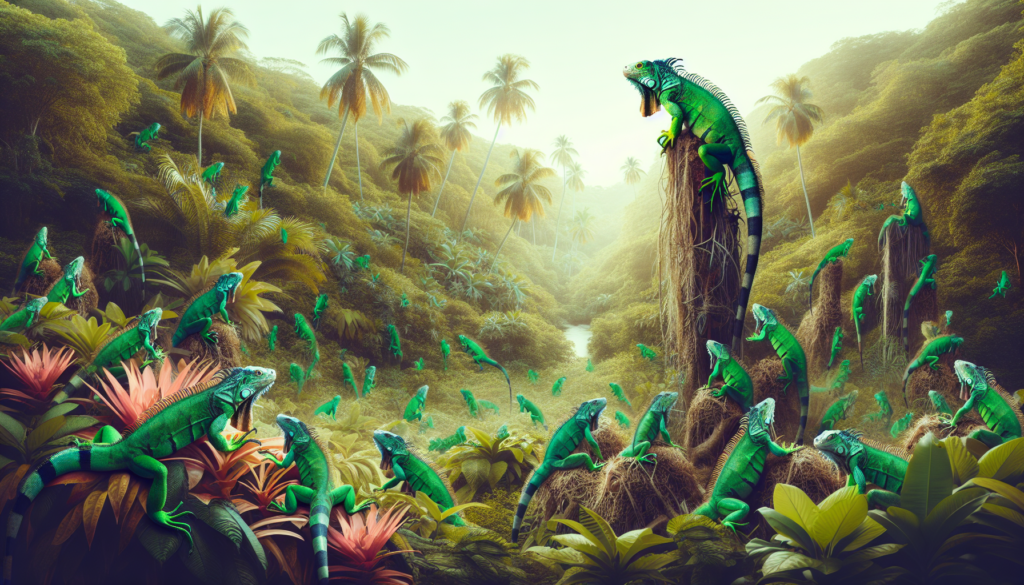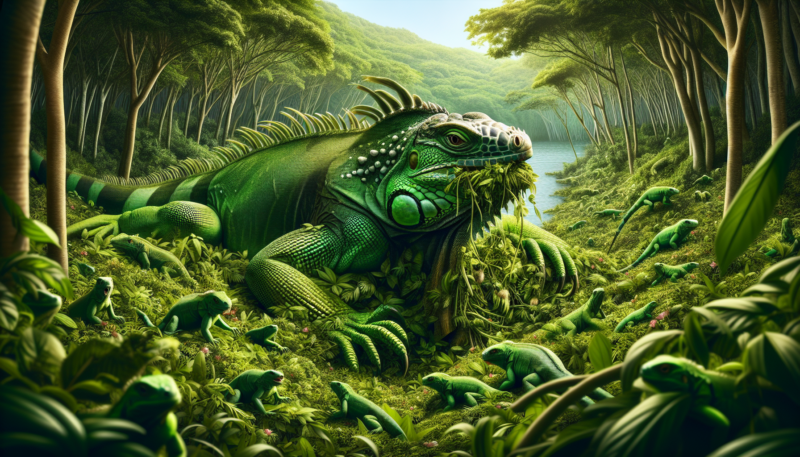Imagine walking through a lush tropical forest, when suddenly, you come face to face with a majestic green iguana. With its vibrant emerald scales and long tail, it’s hard not to be captivated by its beauty. However, beneath this enchanting exterior lies a troubling reality – green iguanas are a highly invasive species. In this article, we will explore why these fascinating creatures have become such a problem and the potential consequences their presence can have on ecosystems. So, strap on your curiosity and prepare to delve into the invasive nature of green iguanas!
Understanding the Invasive Nature of Green Iguanas

Introduction
Welcome to this comprehensive article on understanding the invasive nature of green iguanas! Invasive species pose a significant threat to ecosystems and can have devastating effects on native plants and animals. Green iguanas are a prime example of an invasive species, spreading rapidly and causing ecological and economic damage in many parts of the world. In this article, we will delve into the reasons behind the invasive nature of green iguanas, their environmental and economic impact, as well as management strategies and prevention measures.
Background Information on Green Iguanas
Before we delve into the invasive nature of green iguanas, let’s first explore some background information about these fascinating creatures. Green iguanas, scientifically known as Iguana iguana, are large reptiles native to the tropical rainforests of Central and South America. They are renowned for their vibrant green coloration, ranging from bright green in juveniles to a more subdued green in adults. Green iguanas are arboreal and climbers, spending much of their time high up in trees, basking in the sunlight.
Definition of Invasive Species
To understand the invasive nature of green iguanas, it is essential to define what exactly constitutes an invasive species. An invasive species is a non-native organism that is introduced into a new environment and has the ability to spread rapidly, outcompeting native species and disrupting natural ecosystems. Invasive species can cause ecological harm, economic losses, and pose a threat to human health and well-being.
Reasons for the Invasive Nature of Green Iguanas
Green iguanas have become invasive in many regions due to a combination of factors. Firstly, their natural adaptability and high reproductive rate contribute to their ability to establish and expand populations quickly. They possess the ability to survive and reproduce in a wide range of environments, including urban areas and disturbed habitats.
Additionally, human activities have played a significant role in their introduction and subsequent spread as an invasive species. Green iguanas have been intentionally introduced to areas outside of their native range for various reasons, including the pet trade and agricultural purposes. Escapes and releases from captivity have also contributed to their spread, with individuals finding suitable conditions to thrive in non-native habitats.
Another factor that contributes to the invasive nature of green iguanas is the lack of natural predators in the areas they invade. In their native range, green iguanas have natural predators that help control their population. However, in the regions they have invaded, these predators are often absent, allowing green iguanas to multiply unchecked.

Environmental Impact of Green Iguanas
The environmental impact of green iguanas is profound and far-reaching. One of the primary concerns is the displacement and competition they pose to native species. Green iguanas outcompete native reptiles and birds for food and nesting sites, leading to a decline in native populations. They can also hybridize with native iguana species, further impacting the genetic integrity of native populations.
Habitat destruction is another significant consequence of green iguanas’ invasive nature. Their tendency to burrow and feed on vegetation can damage delicate ecosystems, such as coastal areas and wetlands. These habitats provide essential functions, such as filtering water, buffering against storms, and providing homes for countless other species.
The altered ecosystem functions caused by green iguanas can have cascading effects. Their feeding habits can disrupt plant-pollinator interactions, affecting the reproduction of native plants. They can also disrupt nutrient cycling processes, ultimately leading to changes in soil composition and overall ecosystem health.
Economic Impact of Green Iguanas
The economic impact of green iguanas cannot be underestimated. Agriculturally, they can cause substantial damage by feeding on crops, such as fruits, vegetables, and ornamental plants. This leads to financial losses for farmers and increased costs for consumers. Furthermore, green iguanas’ digging and burrowing activities can damage agricultural infrastructure, including irrigation systems and fencing.
In urban and suburban areas, green iguanas may damage property by digging burrows and nesting in undesirable locations. Their presence can also deter potential homebuyers or renters, leading to decreased property values. Additionally, the tourism and recreation industry can be negatively impacted as green iguanas can become a nuisance to tourists and disrupt natural habitats frequented by visitors.
Management Strategies for Green Iguanas
Managing the invasive nature of green iguanas requires a multi-faceted approach. Research and monitoring efforts are crucial for understanding their populations’ dynamics, distribution, and impact on ecosystems. This information can inform management decisions and help allocate resources effectively.
Control and eradication programs are often implemented to reduce green iguana populations in areas where their invasive impact is significant. These programs may involve trapping and removing individuals, sterilization programs to control reproduction, and, in extreme cases, culling to reduce population size.
Population stabilization techniques that focus on managing green iguana populations in a controlled manner are also being explored. This approach aims to minimize their impact while preserving ecological balance. Examples include introducing sterilized individuals to disrupt breeding patterns or employing fertility control strategies.
Prevention and Control Measures
Prevention is paramount in managing the invasive nature of green iguanas. Strict restrictions on the import and sale of green iguanas as pets can help control the introduction of new individuals to non-native areas. This can be achieved through legislation and enforcement, ensuring that the pet trade operates responsibly and adheres to biosecurity measures.
Promoting responsible pet ownership is another crucial aspect of prevention. Educating potential owners about the potential impacts of releasing green iguanas into the wild is vital in discouraging irresponsible behavior. Encouraging responsible and ethical practices, such as providing proper care, preventing escapes, and rehoming unwanted pets through adoption programs, can significantly reduce the risk of introducing invasive species.
Public education and awareness campaigns can play a significant role in preventing the spread of green iguanas. Informing the public about the ecological and economic consequences of releasing green iguanas into the wild can help deter the practice. These campaigns can also provide guidance on how to recognize and report sightings of green iguanas, allowing for rapid response and containment efforts.
Removal and trapping programs can be implemented to control green iguana populations in highly impacted areas. These programs involve capturing and removing individuals to reduce densities and minimize their impact. Targeted removal efforts may focus on critical habitats or areas where green iguanas are known to cause the most damage.
Legal and Ethical Considerations
When addressing the invasive nature of green iguanas, legal and ethical considerations are paramount. Establishing and enforcing legislation to regulate the import, sale, and possession of green iguanas can help prevent their introduction and spread. It is essential to collaborate with various stakeholders, such as government agencies, conservation organizations, and the pet trade industry, to develop and implement comprehensive measures.
Ethical considerations also come into play when determining control and eradication measures. Balancing the need to protect native biodiversity and ecosystems with the humane treatment of green iguanas is a delicate task. Measures should be developed that prioritize both conservation goals and animal welfare, ensuring the most effective and ethical strategies are employed.
Conclusion
In conclusion, green iguanas have gained notoriety as an invasive species due to their adaptability, high reproductive rate, intentional and unintentional introductions, and lack of natural predators in invaded areas. They have caused significant environmental and economic damage, displacing native species, destroying habitats, and impacting agricultural and tourism industries. Effective management strategies, prevention measures, and public education are vital in combating the invasive nature of green iguanas and preserving ecosystems for future generations. By understanding the causes and implications of their invasiveness, we can work towards finding sustainable solutions and better safeguards to prevent the introduction of other invasive species.
